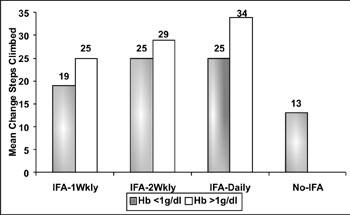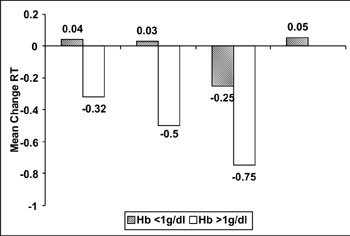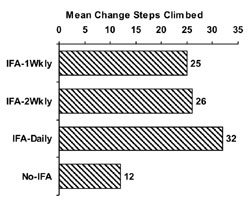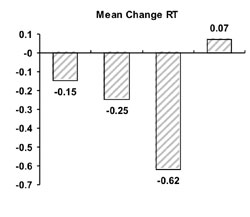|
|
|
Indian Pediatr 2009;46: 849-854 |
 |
Physical Work Capacity of Young
Underprivileged School Girls: Impact of Daily vs Intermittent
Iron-Folic Acid Supplementation – A Randomized Controlled
Trial |
|
A Sen and SJ Kanani
From Department of Foods and Nutrition, The Maharaja
Sayajirao University of Baroda, Vadodara, India.
Correspondence to: Dr Shubhada Kanani, 14, Anupam
Society, Behind Pizza Inn, Jetalpur Road, Vadodara, India.
E-mail: [email protected]
|
|
Abstract
Objectives: To assess impact of daily and
intermittent iron-folate (IFA) supplementation on physical work capacity
of underprivileged schoolgirls in Vadodara.
Design: Randomized controlled trial.
Setting: Municipal Primary schools.
Participants: Schoolgirls (n=163) in the
age group of 9-13 years.
Intervention: Three randomly selected schools
were given IFA tablets (100 mg elemental iron + 0.5 mg folic acid)
either once weekly or twice weekly or daily for one year. The fourth was
the control school.
Outcome Measures: Hemoglobin, modified Harvard's
Step test for physical work capacity.
Results: All three IFA supplemented groups showed
significant improvement in number of steps climbed and recovery time
compared to controls; with impact being relatively better in girls with
higher Hb gain (>1 g/dL) vs. lower Hb gain. Similarly, higher the
frequency of dosing better was the impact- it being the best in daily
IFA group. Twice weekly IFA was as good as daily IFA under conditions of
good compliance.
Conclusion: Twice weekly IFA supplementation is
comparable to daily IFA in terms of beneficial effects on physical work
capacity in young girls.
Keywords: Anemia, Iron-folate supplementation, Physical work
capacity, School girls.
|
|
B
esides being a major threat to safe
motherhood, iron deficiency anemia (IDA) in adolescent girls contributes
to poor growth, lowered resistance to infections, poor cognitive
development and most importantly, decreased work capacity(1). In IDA,
physical work capacity (PWC) is compromised due to decrease in hemoglobin,
which reduces the availability of oxygen to the tissues, and hence certain
tissues and organs that require much oxygen like heart may suffer,
resulting in diminished capacity to perform energy consuming tasks(1,2).
The concentration of myoglobin in skeletal muscle is reduced limiting the
rate of diffusion of oxygen from erythrocytes to mitochondria(1). Thus,
work output, endurance and maximal work capacity are impaired in iron
deficient states.
To combat anemia, initiation of iron supplementation in
the adolescent years has been recommended. Once weekly administration of
iron-folate (IFA) supplements given to adolescent school girls under
supervised conditions has been found to be effective and practical for
raising hemoglobin levels among girls in Indian studies(3-4). Daily IFA
has also shown positive impact on growth of school children and
adolescents(5-6). However, little is known about the benefits of IFA
supplementation on physical work capacity of young school going
adolescents entering the pubertal growth spurt. In adolescent girls, with
high social expectations of meeting the demands of domestic work and
school, decreased PWC may compromise their quality of life. We studied the
impact of intermittent (once and twice weekly) and daily IFA
supplementation on physical work capacity of underprivileged schoolgirls
in early adolescence (9-13 years) in Vadodara.
Methods
This was an experimental-control semi-longitudinal
study; an efficacy trial to assess impact of iron folic acid supplements
on physical work capacity. Prior permission from the Primary School Board,
Vadodara, and informed written consent from students and their parents
were taken. The departmental ethical committee cleared the study.
Sampling: Using accepted procedures, desired sample
size was calculated(7); which came to 46 per group. Allowing for dropouts,
each study group required about 60 subjects of age 9-13 years; which were
available in standards V and VI per school. Thus, four schools were
randomly selected from a sampling frame of 17 schools (all Municipal
primary schools for girls in the morning shift), and all consenting girls
studying in Standards V and VI were enrolled. Students in all four schools
had similar socioeconomic, home and school environment.
Intervention: Three schools were randomly selected
as experimental schools (ES) and were given IFA tablets (100 mg elemental
iron +0.5 mg folic acid) either once weekly (IFA-1Wkly) or twice weekly
(IFA-2Wkly) or daily (IFA-Daily) for one year. The fourth was the control
school (No-IFA). Girls were not dewormed prior to the intervention. The
investigators, with assistance from the class teachers / monitors, ensured
regular supervised distribution and compliance of IFA in all intervened
schools. The tablets were distributed immediately after the tiffin break
(short recess) to ensure they were not taken on empty stomach.
Data collection: Pre and post
intervention hemoglobin data were collected on all girls. In view of the
limited working school days and the time required to conduct physical work
capacity test, a random 60% sample (n=240) was selected. From this,
data of 163 girls was available pre and post intervention; after also
excluding girls who had attained menarche during the study, though they
did receive IFA supplements. None of the girls suffered from illnesses
which might affect work capacity except one girl, who had asthma and was
unwilling to participate. Further, none of the girls was involved in
athletics/sports on a regular basis.
Outcome variables: Hemoglobin levels were assessed
using cyanmethemoglobin method(8). Physical work capacity (PWC) of the
subjects was assessed using Modified Harvard's Step test (MHST)(9); which
has been used in earlier studies on school children in the department and
found to be valid(10). The girls were asked to climb up and down a set of
five steps as fast as they could for three minutes. The total number of
steps climbed up and down was counted. The resting pulse rate was recorded
manually before the girls began the test. Post exercise, the time taken
(minutes) to revert to the basal pulse rate was also recorded (recovery
time). Means and standard deviations were calculated for hemoglobin and
PWC. The mean change in each group was calculated and compared between the
experimental groups and also with the control group. Girls with good
compliance were defined as those who consumed atleast 70% tablets
distributed. To compare various intervention groups for statistical
significance of impact (P<0.05), ANOVA test and to compare each
group with control, students t test was used. All the data were
coded, entered and analyzed in Epi Info, Version 6.04-d.
Results
Mean baseline Hb was similar in all groups (P>0.05);
being 11 to 11.5 g/dL. Post intervention, all intervention groups had
significantly higher mean Hb increment vs. controls, with increment being
highest in IFA-2Wkly (0.97 g/dL) followed by IFA-Daily group (0.93 g/dL).
IFA-1Wkly showed the lowest increment (0.62 g/dL). However, among the
initially anemic girls (Hb<12 g/dL), IFA-Daily group showed highest
increment (1.9 g/dL) followed closely by IFA-2Wkly (1.6 g/dL).
Impact on Physical Work Capacity
Number of Steps Climbed: The mean
increase in number of steps climbed was significantly higher (and almost
twice as high) among supplemented groups (21 to 29 steps) compared to
controls (13 steps) (Table I). Within the supplemented
groups, IFA-Daily girls had significantly higher (P<0.05) increase
in number of steps climbed than IFA-1Wkly. IFA-Daily was followed closely
by IFA-2Wkly; least impact was seen in IFA-1Wkly.
TABLE I
Change in Mean Number of Steps Climbed and Recovery Time-RT (in min) After the Intervention
|
Study Groups |
N |
Increase in Number |
Recovery |
| |
|
of Steps Climbed |
Time |
| |
|
(Mean ± SD) |
(Mean ± SD) |
| IFA-1Wkly
|
43 |
21 ± 13.53 |
–0.12 ± 0.73 |
| IFA-2Wkly
|
42 |
27 ± 21.33 |
–0.17 ± 0.73 |
| IFA-Daily
|
44 |
29 ± 15.61 |
–0.48 ± 0.73 |
| No-IFA
|
34 |
13 ± 16.26 |
0.06 ± 0.60 |
| F test |
|
P<0.001 |
P<0.01 |
|
•Comparing each experimental group (EG) with control:
Increase in steps climbed- all EG were significantly better (IFA-1Wkly
P<0.05; IFA 2Wkly P<0.01, IFA-Daily P<0.001); RT: only IFA-Daily was
significant (P<0.001).
•Within experimental groups: Increase in steps climbed
and RT improvement; IFA-Daily was significantly better than IFA-1Wkly
(P<0.05). |
Recovery time: The improved recovery time (RT), was
significantly better in IFA-Daily than No-IFA group (Table I).
Although there was decrease in RT in IFA-2Wkly and IFA-1Wkly, this was not
significantly better than No-IFA. There was slight increase in the RT of
the girls in No-IFA group.
Influence of compliance with IFA: In
each treated group, girls with good compliance showed better impact than
those with poor compliance and this difference was significant in IFA-Daily.
Within good compliance, comparing the groups, the increment in number of
steps climbed or recovery time was the best in IFA-Daily but between
groups, differences were not significant (Table II).
However, within poor compliance, between-group difference was significant,
with IFA-Daily showing best impact and IFA-1Wkly showing least impact
(increase in RT).
TABLE II
Number of Steps Climbed and Recovery Time (in min) After MHST in
Girls With Good Compliance and Poor Compliance
| |
|
Good Compliance1 |
|
Poor Compliance2 |
'P' |
Study
Groups |
N |
Initial |
Final |
Mean
change
(A) |
N |
Initial |
Final |
Mean
change
(B) |
Value
A vs B |
|
Number of Steps Climbed (Mean ± SD) |
| IFA-1Wkly
|
26 |
171±28.27 |
195±24.43 |
24±14.34 |
17 |
166±20.03 |
184±20.56 |
18±11.06 |
>0.05 |
| IFA-2Wkly
|
30 |
181±40.56 |
208±31.48 |
29±24.69 |
12 |
178±39.57 |
201±30.24 |
23±15.05 |
>0.05 |
| IFA-Daily
|
27 |
188±32.59 |
221±28.71 |
34±14.35 |
15 |
191±34.45 |
212±2 5.18 |
22±15.77 |
<0.05 |
| P Value |
|
|
|
>0.05 |
|
|
|
>0.05 |
|
|
Recovery time (RT) (Mean ± SD) |
| IFA-1Wkly |
26 |
3.88±0.86 |
3.50±0.94 |
–0.38±0.69 |
17 |
3.88±0.78 |
4.17±0.08 |
0.29±0.58 |
<0.01 |
| IFA-2Wkly
|
30 |
2.76±1.07 |
2.53±0.63 |
–0.23±0.77 |
12 |
2.75±0.75 |
2.75±0.75 |
0.00±0.60 |
<0.05 |
| IFA-Daily
|
27 |
3.29±0.95 |
2.59±0.64 |
–0.70±0.77 |
15 |
2.46±0.64 |
2.26±0.59 |
–0.20±0.41 |
<0.05 |
| P Value |
|
|
|
>0.05 |
|
|
|
<0.05 |
|
Values are Mean ± SD; 1Compliance of 70% of IFA dose, 2Compliance of < 70% of IFA dose.
|
Hemoglobin gain and physical work capacity
Figure 1 shows that the mean increase in the
number of steps climbed was higher among those who gained Hb levels
³1
g/dL compared to those with Hb increase <1 g/dL, the difference being
significant in IFA-2Wkly and IFA-Daily groups. In the group which gained
³1
g/dL Hb, the increase in number of steps climbed was highest in IFA-Daily,
(which was significantly better than IFA-1Wkly group), followed by
IFA-2Wkly. On comparing the change in the recovery time, it was clear the
decline in the RT was higher amongst those with higher Hb increments (Fig.2).
Further, more frequent the dosing, better the impact. The trends were
similar when only good compliance girls were considered.
 |
 |
| Fig. 1 Mean
change in steps climbed - girls with Hb gain>1 g/dL vs. girls with
Hb gain< 1g/dL. |
Fig. 2 Mean
change in recovery time- girls with Hb gain>1 g/dL vs. girls with Hb
gain <1g/dL. |
Initial level of anemia and physical work capacity
Considering only anemic girls (Hb <12 g/dL), the mean
increase in the number of steps climbed in all intervened groups was
significantly better than in controls (Fig. 3). Within the
intervened groups, increase in number of steps in IFA-Daily was
significantly higher than in IFA-1Wkly. The differences in the increase in
steps among anemic girls in IFA-2Wkly and IFA-1Wkly were non-significant.
In terms of change in recovery time, only those who received daily doses
and were initially anemic showed significant decrease in the RT compared
to No-IFA. Therefore, daily supple-mentation of iron folate tablets
significantly improved the work capacity among anemic girls in terms of
increase in number of steps climbed and decrease in recovery time.
 |
 |
| Fig.
3 Number of steps climbed and recovery time in initially
anemic girls after the intervention. |
Discussion
The findings of this study indicate that among the
intervention groups (as compared to controls), the IFA-Daily group showed
the maximum impact followed by IFA-2Wkly as regards improvement in PWC in
terms of significantly higher increase in the number of steps climbed and
improvement (reduction) in recovery time (RT). IFA-1Wkly showed least
impact; though it was better than control. These trends remained when
subgroups like ‘girls with good compliance’, and ‘anemic girls’ were
considered. Girls who gained more Hb (>1 g/dL) showed better improvement
in PWC vs. those who gained Hb<1 g/dL; in all treated groups.
Higher the frequency of IFA supplementation (daily and twice weekly),
better the improvement in hemoglobin and PWC.
Data on impact of IFA on PWC among school children and
adolescents is scanty in literature. Supplementation of 60 mg iron per day
to non-pregnant female workers in Beijing reduced mean heart rate, and
increased the production efficiency. Iron supplementation enabled the
female workers to do the same work at lower energy cost(11). A randomized
double-blind placebo-controlled trial has been reported in Sri Lanka(12)
on 20-60 years old female tea estate workers. The first study group
received 200 mg FeSO4 for 1 month and the second study group received 200
mg FeSO4 for 3 wks. There was a net increase of 1.5 g/dL in Hb level. The
amount of tea picked increased by 1.2%. The heart rates were significantly
lower after supplementation. In South India, young adult women given 60 mg
of iron for 100 days showed reduced energy expenditure for physical
activities like walking, running, climbing, skipping and sweeping. The
mean distance covered by anemic women while walking increased from 8
meters/min to 14 meters/min after iron supplementation. The exertion on
heart as shown through blood pressure and pulse rate, also reduced after
supplementation(13).
In rural Varanasi, UP, India, a study on school
children (6-8 years) over one year (170 working days) assessed the impact
of iron supplementation (Iron syrup: ferrous gluconate 200 mg) on physical
growth, physical stamina, mental function and academic performance(14) and
reported that the supplementation did not influence the performance of
children on the parameters of Harvard step test; but mean scores for
recovery period were better for the supplemented group than controls after
a 300 meter run-cum-walk. Studies conducted in this department in Vadodara
using Modified Harvard Step Test to assess the work performance of anemic
preschool children(15) and using indicators like increase in the number of
skips done by school girls with a skipping rope reported a significant
improvement in PWC of iron treated subjects compared to controls(10).
Our study has shown that while once-weekly IFA may not
suffice; twice weekly IFA has the potential to lead to significant
improvement in physical work capacity at less cost and greater feasibility
as compared to daily IFA supplements; this however needs to be further
explored through randomized control trials on larger samples. Another
important observation emerging from this study is that IFA supplementation
should be initiated not just in secondary schools as at present is the
case in Gujarat, but earlier in primary school (classes V-VII) when
children are entering adolescence and when iron demands are high for
growth and development.
Contributors: AS collected, analysed and
interpreted the data and performed literature review and drafted the
manuscript. SJK designed the study, supervised data collection, analysis.
She also revised and approved the final manuscript.
Funding: None.
Competing interests: None stated.
|
What is Already Known?
• Daily and once-weekly iron-folate
supplementation improve hemoglobin levels among adolescent girls.
What This Study Adds?
• Intermittent iron folate supplementation (daily
and twice weekly) significantly improves work capacity and decreases
recovery time among school girls compared to once weekly and anemic
girls benefit more from Daily IFA supplementation.
|
References
1. Beaton GH, Corey PN, Steele C. Conceptual and
methodological issues regarding the epidemiology of iron deficiency and
their implications for studies of the functional consequences of iron
deficiency. Am J Clin Nutr 1989; 50: 575-588.
2. Bothwell TN, Carlton RW, Cook JD, Finch CA. Iron
Metabolism in Man. 1st edition. England. Oxford: Blackwell Scientific
Publication; 1979.
3. Agarwal KN, Gomber S, Bisht H, Som M. Anemia
prophylaxis in adolescent school girls by weekly or daily iron-folate
supplementation. Indian Pediatr 2003; 40: 296-230.
4. Kotecha RV, Patel RZ, Karkar PD, Nirupam S. Impact
evaluation of adolescent girl's anemia reduction program Vadodara
district. Government of Gujarat, India. 2002.
5. Kanani S, Poojara RM. Supplementation with IFA
enhances growth in adolescent Indian girls. J Nutr 2000; 130: 452S-455S.
6. Lawless JW, Latham MC, Stephenson LS, Kinoti SN,
Pertet AM. Iron supplementation improves appetite and growth in anemic
Kenyan primary school children. J Nutr 1994; 124: 645-654.
7. Fisher AA, Laing J, Stoeckel J, Townsend JW.
Handbook for Family Planning, Operations Research Design. 2nd edition. New
York: The Population Council; 1991.
8. International Nutritional Anemia Consultancy Group.
Guidelines for eradications of iron deficiency anemia. A report of
international nutritional anemia consultancy group (INACG). New York and
Washington DC: INACG; 1985.
9. Skubic V, Hodgkins J. Cardiovascular efficiency test
scores for junior and senior high school girls in the United States. Res Q
1964; 35: 184-192.
10. Kanani S, Singh P, Zutshi R. The impact of daily
iron vs. calcium supplementation on growth, physical work capacity and
mental functions of school going adolescent boys and girls (9 to16 yrs) of
Vadodara. Department of Foods and Nutrition, The M. S. University of
Baroda, Vadodara, India. 1999.
11. Li R, Chen X, Yan H, Deurenberg P, Garby L,
Hautvast JG. Functional consequences of iron supplementation in
iron-deficient female cotton mill workers in Beijing China. Am J Clin Nutr
1994; 59: 908-913.
12. Edgerton VR, Gardner GW, Ohira Y, Gunawardena KA,
Senewiratne B. Iron-deficiency anemia and its effect on worker
productivity and activity patterns. Br Med J 1979; 2: 1546-1549.
13. Vijayalakshmi P, Selvasundari S. Relationship
between iron deficiency anemia and energy expenditure of young adult
women. Indian J Nutr Dietet 1983; 20: 113-117.
14. Agarwal DK, Upadhyay SK, Tripathi AM, Agarwal KN.
Nutritional status, physical work capacity and mental function in school
children. New Delhi: Nutrition Foundation of India; 1987.
15. Seshadri S, Malhotra S. Effect of hematinics on physical work
capacity in anemics. Indian Pediatr 1984; 21: 529-533.
|
|
|
 |
|

